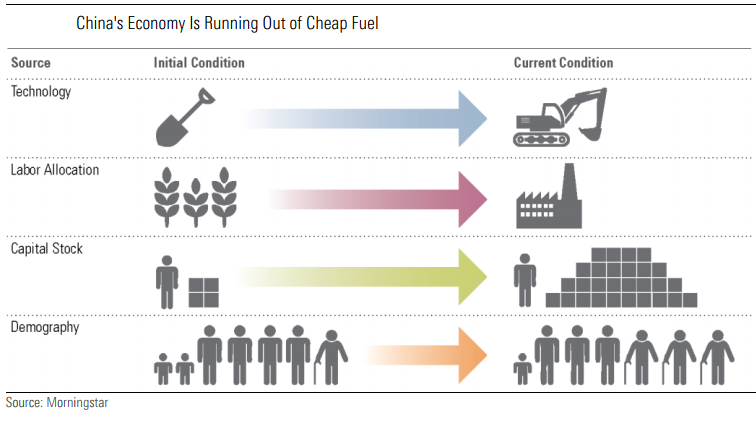What Next for China's Economic Growth?
Ever since China's economy began to slow from last decade's double-digit pace, investors have been divided over the country's growth prospects. At various times in the past several years, bulls and bears have each glimpsed apparent victory, only for a reversal of China's credit cycle to change the narrative.
The long-term outlook remains unsettled and the debate continues. Perhaps no question matters more to investors globally. Over the past 10 years, China has been the single largest contributor to global GDP growth, accounting for nearly one third of the world total. Meanwhile, China has become the world's biggest buyer of everything from automobiles to airplanes to oral hygiene products.
The bullish side of the debate often points to China's remaining potential for "catch-up" growth, which should portend slower, albeit robust growth for many years to come. As a whole, China remains poorer and more agricultural than rich countries. Within China, there's scope for catch-up too.

Interior provinces are far less developed than their coastal peers. Prominent bull Justin Yifu Lin, former chief economist at the World Bank and long-time advisor to top leadership in Beijing, has long cited China's relative poverty as the biggest reason for his optimism, noting that Japan, Singapore, Taiwan, and South Korea all enjoyed decades of 7%-plus GDP growth after they had reached the rung on the income ladder that China finds itself at today.
Others are more circumspect. Over the past half-century, the typical country at China's income level posted 4% average annual GDP growth in the 10 years that followed. That's well below the consensus medium-term outlook for China of roughly 6%, as well as Beijing's goal of 6.4% through 2020. Bears fret that even an "average" outcome would be optimistic, given the excesses that have built up following repeated rounds of stimulus and the disappointing pace of reform.
Why Has Growth Slowed?
China's economy has slowed markedly this decade. But the extent of the slowdown is debatable. Government statistics portray a gradual decline—an apparent soft landing for what had been the world's highest-flying economy. By contrast, most independent estimates, such as those from economist Harry X.
Wu at The Conference Board's China Center, suggest a bumpy descent punctuated by periodic bursts of stimulus. So too do alternatives such as the so-called "Li Keqiang Index," as well as our "power proxy" based on sector-level electricity consumption data.
Few expect a return to high-single-digit growth in the years to come, much less the double-digit pace of the prior decade. But many believe growth is unlikely to slow much further from the prevailing rate, 6.7% in the first half of 2017. The International Monetary Fund's most recent forecast envisions GDP growth averaging 6.1% through 2022. Most sell-side analysts expect something similar, although a minority, including ourselves, express a more bearish view.

Regardless of which side proves right, there seems little doubt that official statistics published several years from now will claim the Party achieved its goal of doubling 2010 GDP by 2020. This would require, on average, 6.4% GDP growth from 2017 through 2020. But investors, of course, get paid out of company cash flows, which are derived from real economic activity, not official figures. In pondering the long-term trajectory of China's economy, it's instructive to first consider the underlying sources of the country's slowdown.
Faltering productivity growth explains much of China's economic slowdown. We estimate total factor productivity growth of 2.3% annually in the current decade, down from 4.8% in the 2000s. Dwindling productivity gains account for roughly three fourths of the decline in GDP growth over that interval.
Productivity gains are shrinking because the conditions that made heady growth possible are fading away. China is no longer a technologically backward, rural economy with an underdeveloped capital stock and a rapidly growing workforce. GDP growth will come under further pressure as prior sources of productivity gains are fully exhausted, casting doubt on consensus expectations that China can sustain 6% growth in the medium term. Beijing will find it increasingly difficult to "engineer" the desired GDP growth rate, as each round of stimulus undermines the economy's productivity growth prospects.

 Yahoo Finance
Yahoo Finance 